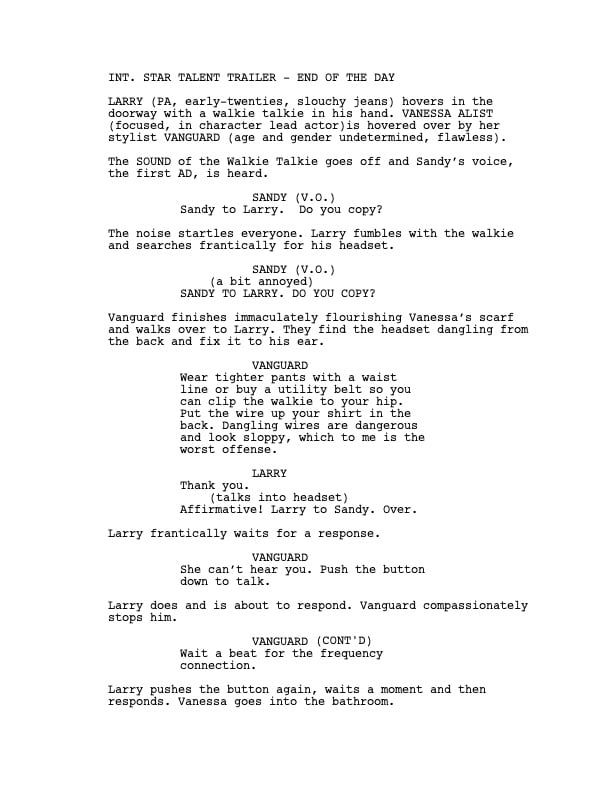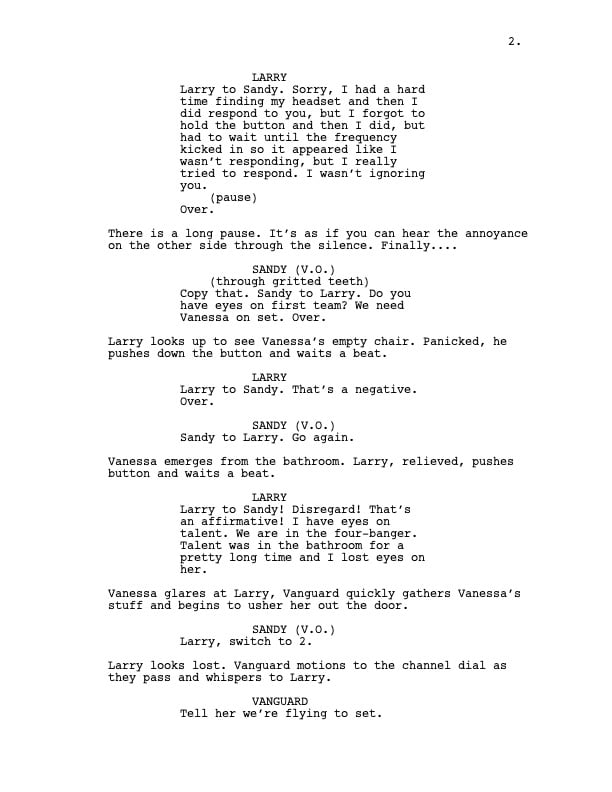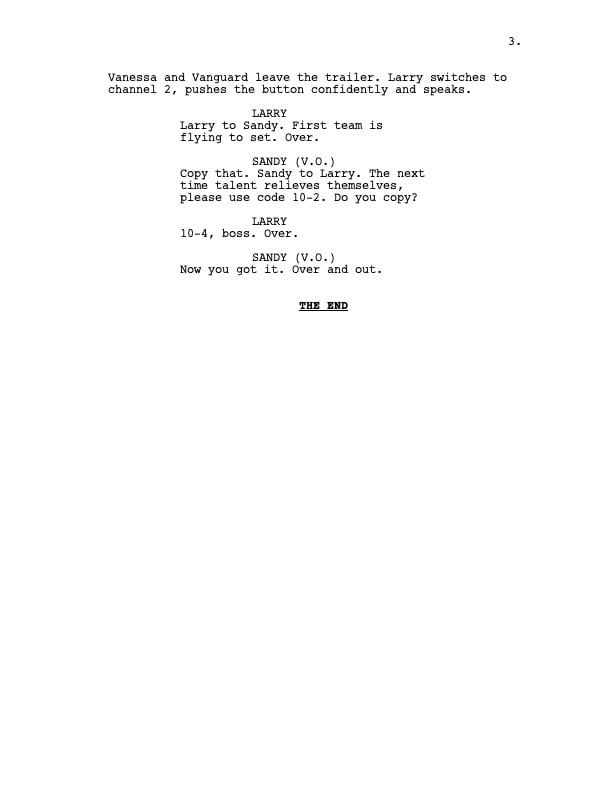Film Set Walkie Talkies
Production crews on a film set work at a breakneck pace to make their days. That’s why it’s essential to have clear, consistent communication to avoid costly mistakes or delays. Walkie Talkies or two-way radios are industry standard for movie crews to communicate quickly, efficiently, and effectively without wasting time. And they have developed specialized walkie talkie lingo to make conversations between departments faster and clearer.
The problem for those new to production is that film set walkie talkie lingo can be complicated and no one really trains them on the terms or hands them a cheat sheet on their first day. However, to work professionally this is something everyone in the film crew hierarchy needs to know.
To get new crew members up to speed, we’ve put together a guide to familiarize everyone with the walkie talkie headset, walkie talkie lingo, department channels, walkie talkie codes and walkie talkie radio etiquette.
Properly Wearing the Walkie Talkie Headset
There isn’t a set style or type of walkie talkie, however the motorola is the most common walkie talkie found on sets as they have a reputation as being durable and reliable.
Generally speaking, professional film sets will use a commercial grade walkie talkie that has impact and weather resistance, long battery life and versatility. For example, because sets are often noise controlled, the ability for radio communication to be silenced and set to vibrate, rather than beep is essential.
You may want to invest in accessories that can aid in ease of use and accessibility, such as carry accessories (a utility belt or clip) and earpieces. Typically, when you are given the walkie talkie it will come with an earpiece, but having your own for better sound quality and sanitation is a good investment.
Wear your walkie talkie correctly. Dangling wires are dangerous. You should run the wires up the back of your shirt so the earpiece fixes over your ear correctly. Fumbling around for your mic when someone is calling you is something you want to avoid. Clip your mic to your collar so it’s within reach for you to respond, with the right walkie talkie communication, quickly.
Walkie Talkie Channels
As a new producer or crew member on a busy set there is bound to be important information you’ll need to know or convey. To save time and keep it brief, walkie talkie lingo was developed. You want to know a crew member’s location? There’s a code for that. You need to step off the set quickly to dash to the bathroom? There’s a code for that.
The first thing you’ll want to do is check your call sheet for the channels. A channel is a specific frequency band. Walkie talkie radios are all "receiving," so when a crew member wants to talk to another, you need to hold the push-to-talk button on the handset. The radio goes quiet as the loudspeaker switches over to a microphone. This is important to know because if you don’t hold the button while talking, you’ll have a ton of annoyed and frustrated crew throwing shade your way. Conversely if you accidently hold down the button, known as “keying”, you will interrupt all radio communication for everyone using the channel.
For the most part, channels are consistent from set to set, but still good to be aware of. Here is a typical breakdown:
- Channel 1: Main channel used by Production Assistants and Coordinators.
- Channel 2: Open channel for longer conversations.
- Channel 3: Transportation
- Channel 4: Open channel
- Channel 5: Open channel
- Channel 6: Camera
- Channel 7: Electric
- Channel 8: Grip
Learn your department’s channel, stay tuned to that channel when not using your radio, and check the call sheet every day for any changes.
Walkie Talkie Lingo
Walkie Talkie communication has its own lingo with language and codes. This is developed to keep talk to a minimum and productivity high. Film sets can be pressure cookers with a ton of moving parts and clear, brief directives are key to success.
Here is a chart with frequently used walkie talkie codes.
|
Code |
Description |
|
10-1 |
Alerting to a quick bathroom break |
|
10-2 |
Alerting to a longer bathroom break |
|
10-4 |
The message is understood. You can also say “roger that”. |
|
20 |
A set person’s location. As in “what’s your 20?” |
|
86 |
When something needs to be removed. Also called “strike”. As in “86 the watch on the end table” |
|
Affirmative |
Yes |
|
Negative |
No |
|
Copy |
Message heard and understood. Or used when asking if a message was received such as “Do you copy?” |
|
Disregard |
Ignore the previous message |
|
Over |
Message finished, awaiting reply. |
|
Out |
Finished communicating and leaving the conversation for now. |
|
Go again |
Asking to repeat the last message. |
|
Radio check |
Also called “walkie check”. Checking to see if your radio is working. |
|
Loud and clear |
Also called “check good”. Common reply to someone checking if their radio is working properly. |
|
Go for |
Reply to someone calling your name and that you hear them. More specific than just “copy”. Such as “Go for George”. It can also be person to person such as “Sandy for George” |
|
On it |
You are in the process of completing the task asked of you. |
|
Stand by |
Acknowledging you heard, but too busy to reply now. |
|
Standing by |
At the ready and waiting for further instructions. |
|
Eyes on |
You can see the subject such as “eyes on director” or you are requesting if anyone sees it such as “does anyone have eyes on the director?” |
|
Lock it up |
You are about to roll the camera, and no one is allowed to pass through. You are locking up an area to traffic. |
|
Flying in |
A prop is coming in or a person is on their way. |
|
Keying |
A person accidentally holding or bumping the talk button on their radio. |
|
Spin that |
When a message needs to be conveyed to another radio channel. Example: “Spin that message to hair and makeup on channel 4, please.” |
|
Kill |
To turn something off. Example: “Kill the stage lights.” |
|
Going off radio |
You are turning off your radio and won’t be in communication. |
|
First Team |
The principal actors in a scene. |
|
Second Team |
The stand-ins for the principal actors. |
Helpful Film Specific Lingo
There are a few film set slang terms that aren’t specifically for the walkie talkie but you’ll hear them used over the radio and it’s good to know. This is a list of some of the most common terms you’ll hear over the walkie talkie.
|
Film Lingo |
Description |
|
Abby Singer |
The second to last shot of the day. |
|
Martini |
The last shot of the day. |
|
Apple Box |
A wooden box closed on all six sides, with finger grips cut into two opposing sides for carrying. It is used for sitting, standing, temporary platforms, and more. |
|
Back to One |
This refers to doing another take and having everyone (actors, camera, crew, etc.) go back to their starting positions for the shot. |
|
Final Checks |
Wardrobe / Make Up / Art – check your department, we’re going for a take. |
|
Hot Points |
Grips will call out this term to indicate they are carrying something such as a light stand with the tips pointing forward. Look out if you hear this. |
|
Pick Up |
Doing another take of a shot, but only part of it, starting part-way through the beginning. |
|
Bogies |
Unwanted people on set |
|
Hot Brick |
A fully-charged battery |
|
Baby Legs |
The legs of a camera tripod |
|
Four-banger |
A large trailer with four doors, a production room, a dressing room, and a crew bathroom. |
Walkie Talkie Etiquitte
The best advice is to speak slowly, clearly and keep it short. It’s frustrating for the crew if directives are hard to hear, cut off, or conversely long winded and chatty.
Here are some helpful tips.
- When you first turn on your walkie talkie, do a radio check. That is simply saying “walkie check” or “radio check” and then waiting for someone to respond with “good check” or “loud and clear” so you know the radio is working.
- Wait a beat before you talk to allow the connection to be established. You want to be heard and understood the first time you speak.
- Figure out your moderate volume (you don’t want to be too loud or too quiet on the walkie).
- Don’t hold the mic too close to your face or your voice will be muffled. 3 to 5 inches away is good.
- Relinquish your walkie if someone senior to you runs out of battery.
- Before you get on the walkie, know what you need to say. Be direct and keep it short, don’t meander.
- Learn your crew's voices so you don’t have to constantly ask who is talking.
- Always listen and wait before you reply. Don’t cut anyone off and always acknowledge that you understood the message.
- Remember everyone can hear you. Always be professional, don’t joke or simply chat about anything unrelated to the shoot.
- Check your attitude at the door and be polite. Abusive and offensive behavior is never okay.
Walkie Talkie Lingo in Action
Film is all about showing and not telling. We thought we’d leave you with a screenplay version of walkie talkie lingo to best illustrate its usage.




